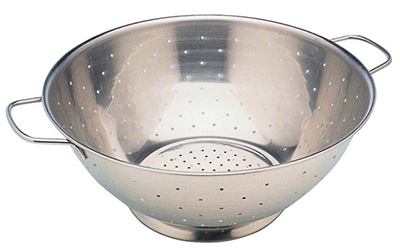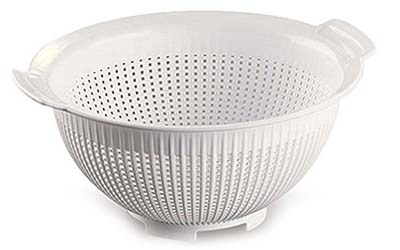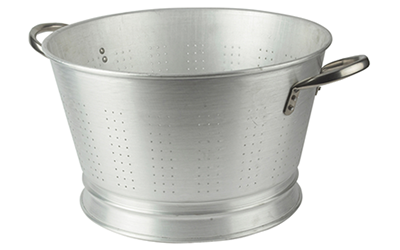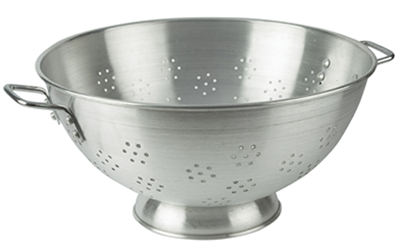What’s The Difference Between A Colander And A Strainer?

Colanders are complicated pieces of kitchenware. They seem to be everywhere and in every kitchen, but what exactly are they used for? A colander, as defined by The Cambridge Dictionary, is “a bowl with small holes in it, used for washing food or for emptying food into when it has been cooked in water.” The perforated nature of the colander allows liquid to drain through while retaining the solid food inside.
A colander is sometimes called a pasta strainer or kitchen sieve, which makes it a bit confusing when it comes to determining the difference. Sieves have a more specific use, they are often used for sifting flour when baking and sometimes straining liquids, such as soups and sauces.
Different Types Of Colanders
With so many different materials and types of colanders, it can be difficult to know where to start. Here at Cooksmill, we stock a wide range of colanders, each having different pros and cons depending on what you’re cooking or cleaning.
Stainless Steel Colanders are durable, rust-resistant and easy to clean. These colanders are workhorses in busy kitchens and can handle frequent and daily use. They are best for washing and draining large fruits and vegetables as the metal won’t rust from the acidity of the fruit. These colanders can also be used to wash salads and fresh produce.
Plastic Colanders are fantastic for everyday use in household and domestic kitchens. They offer a more lightweight alternative and their ease of handling makes them ideal for everyday use. Plastic colanders are better suited for draining pasta. Our plastic colanders are crafted from high-quality, food-safe plastics that ensure your food is quickly drained and ready to eat.
Aluminium Colanders have precision-pierced holes that allow water and other liquids to drain quickly while keeping the ingredients contained within the colander. There is a useful, large base that allows you to lay the colander in the sink without worrying about the contents contacting anything else. The tapered design of our aluminium colanders allows the colander to be placed inside other items such as pans on the stovetop.
Professional Colanders are the top choice for commercial kitchens. Made from a mix of aluminium and steel. These colanders ensure exceptional durability and reliability. Our professional colanders prioritise culinary precision by providing the perfect balance between hole size and density. The hole patterns ensure efficient drainage while preventing smaller food items from escaping.
Colander As A Steamer?
If you’re in a rush, you’ll be happy to know that a colander can be used as a makeshift steamer! This makes these handy tools a great all-rounder in the kitchen, especially if something needs steaming quickly.
How to use a colander as a steamer:
- Fill the pot with water: Aim for about an inch or two below the bottom of the colander.
- Bring the water to a simmer: Don't let it boil vigorously, as you want gentle steam circulation.
- Place the colander inside the pot: Make sure it's stable and not resting directly on the water.
- Add your food to the colander: Arrange it in a single layer for even cooking.
- Cover the pot tightly: Use a lid that fits snugly to trap the steam.
- Steam your food: Follow the recipe's recommended steaming time or adjust based on the food's thickness. Check on it periodically to ensure it's not overcooked.
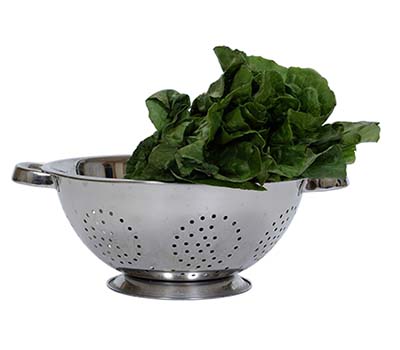
For the best result when steaming, choose a steel colander with smaller holes for better efficiency. Plastic colanders should not be used for steaming as they could melt. If the steam starts to escape quickly, crack the lid open a little to prevent pressure build up. Steaming with a colander might be trickier with more delicate food items like small vegetables or leafy greens, instead, stick to larger vegetables and sturdier items of food. If you're in a bind or just need a quick and simple way to steam some food, a colander can definitely get the job done in a pinch!
Colander vs Sieve vs Strainer
As we’ve already established, a colander and a sieve are very different. Strainers are also different, strainers are made from fine mesh with tiny openings for liquids to pass through. Strainers are key when it comes to preparing dishes that require ingredients to be sifted, drained or strained. These tools are handy for bakers and precision cooks who need the perfect texture for their meals. Handwashing is recommended for strainers to ensure they stay in the best condition for longer.
Kitchen sieves are made for sieving flour and other fine ingredients when it comes to baking. Our sieves are great for sieving dry ingredients, like flour, spices, and coffee, thanks to the mesh at the bottom. Perfect for bakers and pastry makers, they can be held at the size and sieved, which makes food prep easy and quick. A majority of our sieves are dishwasher safe, although hand washing is recommended if food debris becomes stuck in the bottom of the sieve to preserve the fine mesh design.
Colanders have cemented themselves as quality kitchen tools that can be used for a wide range of food preparation tasks. Colanders are mainly used for cooking needs, like steaming vegetables or straining already cooked food groups, like pasta. Essential for any chef, domestic or professional, a colander’s use is undeniable in the kitchen. Most colanders are easy to stack amongst other pots and pans as well, resulting in easy storage.
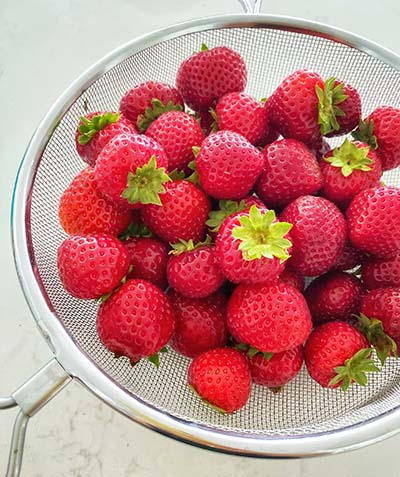
How To Clean Your Colander
If you look after your colander well, you can count on the handy tool being the backbone of your kitchen for years to come. Colanders do not require any special cleaning methods. Their easy cleaning is yet another reason why kitchens of any calibre should equipt themselves with a colander. Different materials will require different cleaning. Stainless steel colanders are dishwasher safe, making them a fantastic choice for busy kitchens who need to save time on cleaning dishes. Professional colanders are also dishwasher safe.
Plastic colanders and aluminium colanders should be handwashed, due to the more sensitive construction. These colanders can be washed easily and quickly with warm water and soap, and left to air dry. If food debris becomes stuck at the bottom of your colander, no matter the material, this should be removed by hand to prevent scratches or even bending of the material.
Cool Colanders With Cooksmill
Although the humble colander may have been overlooked before, it won’t be anymore! Colanders are versatile, reliable and a handy piece of kitchenware to own. Cooksmill has every type of colander you could dream of, whether you’re a novice baker or a professional chef, look no further for the new coolest addition to your kitchen.


